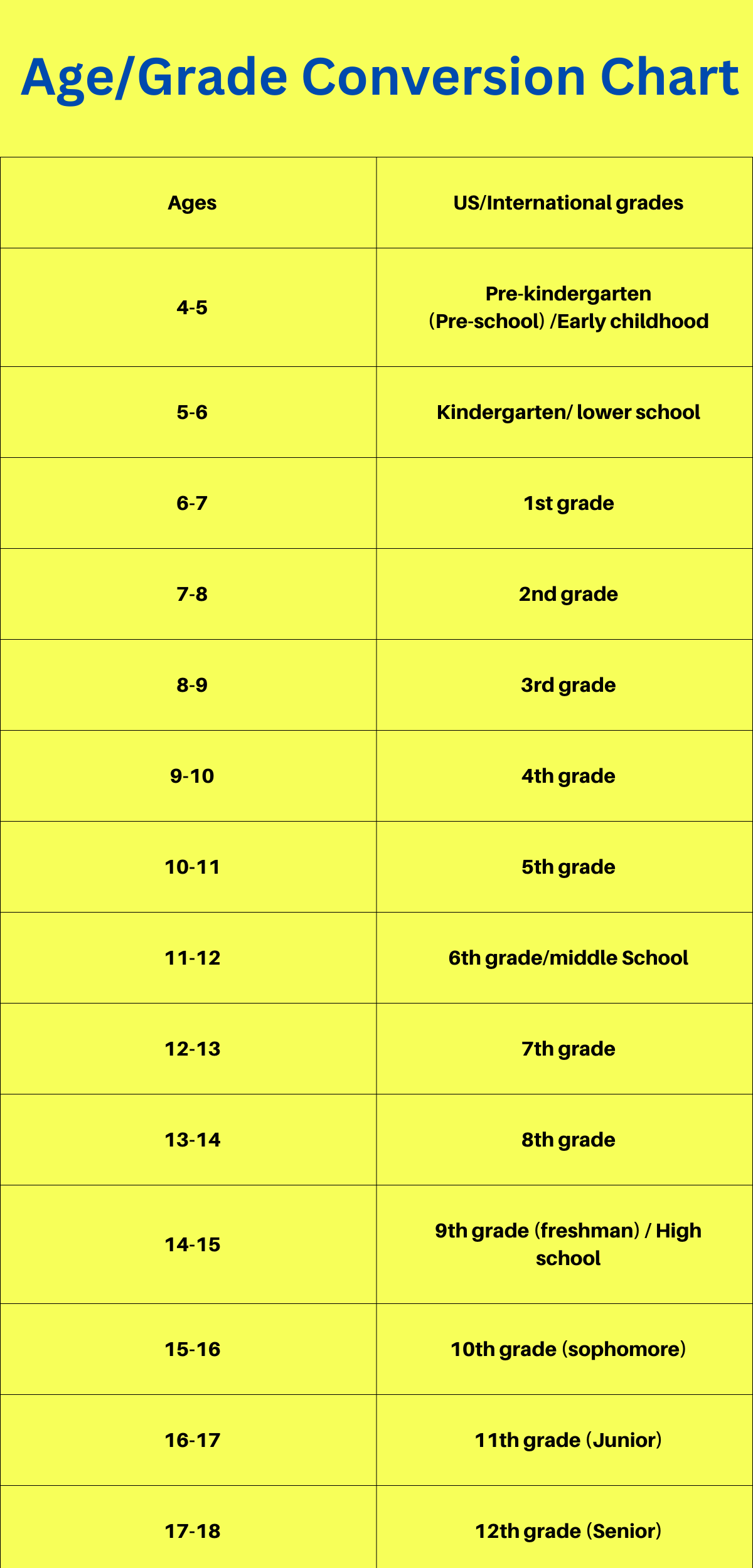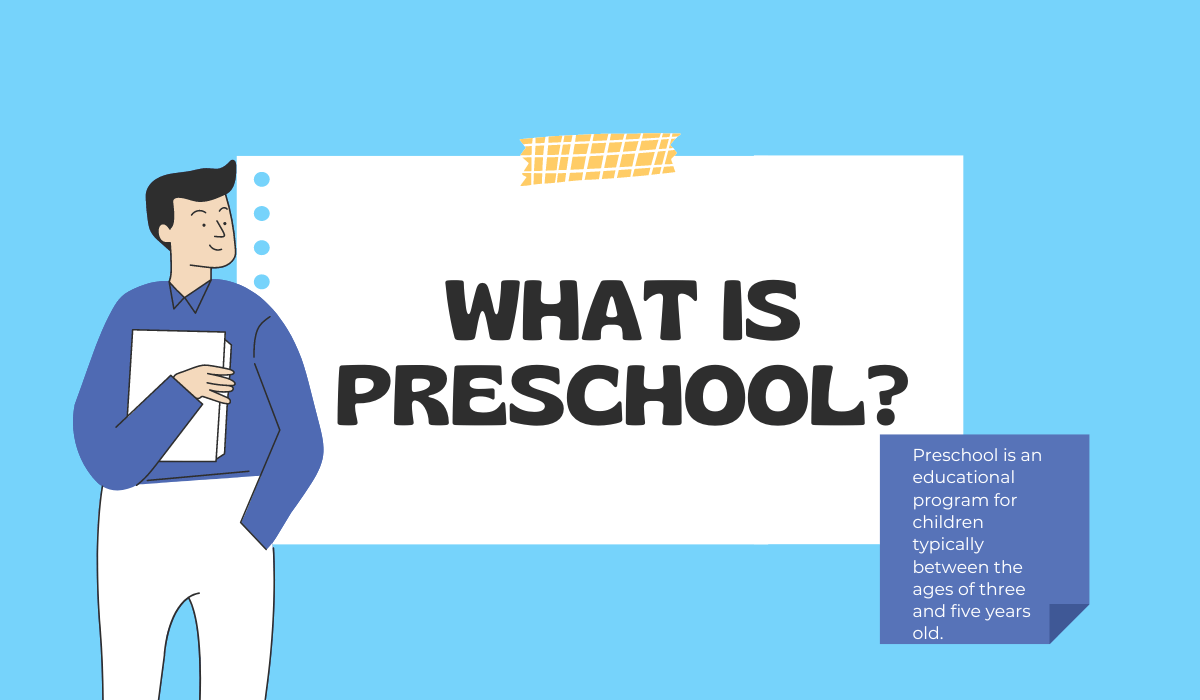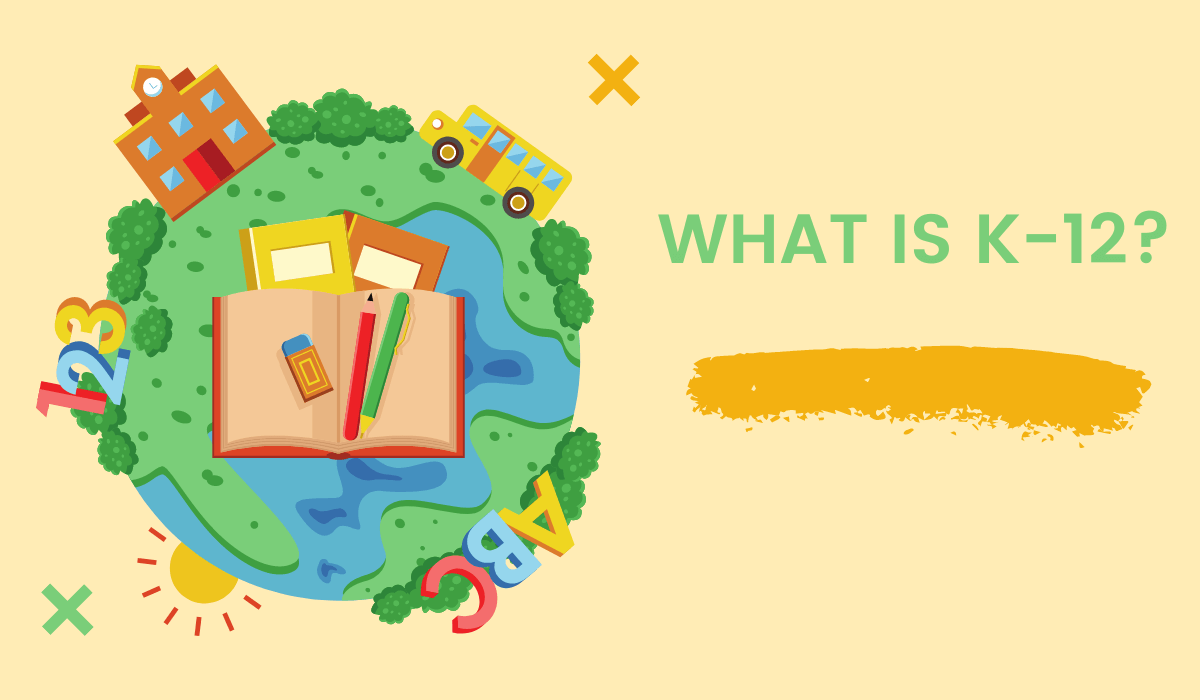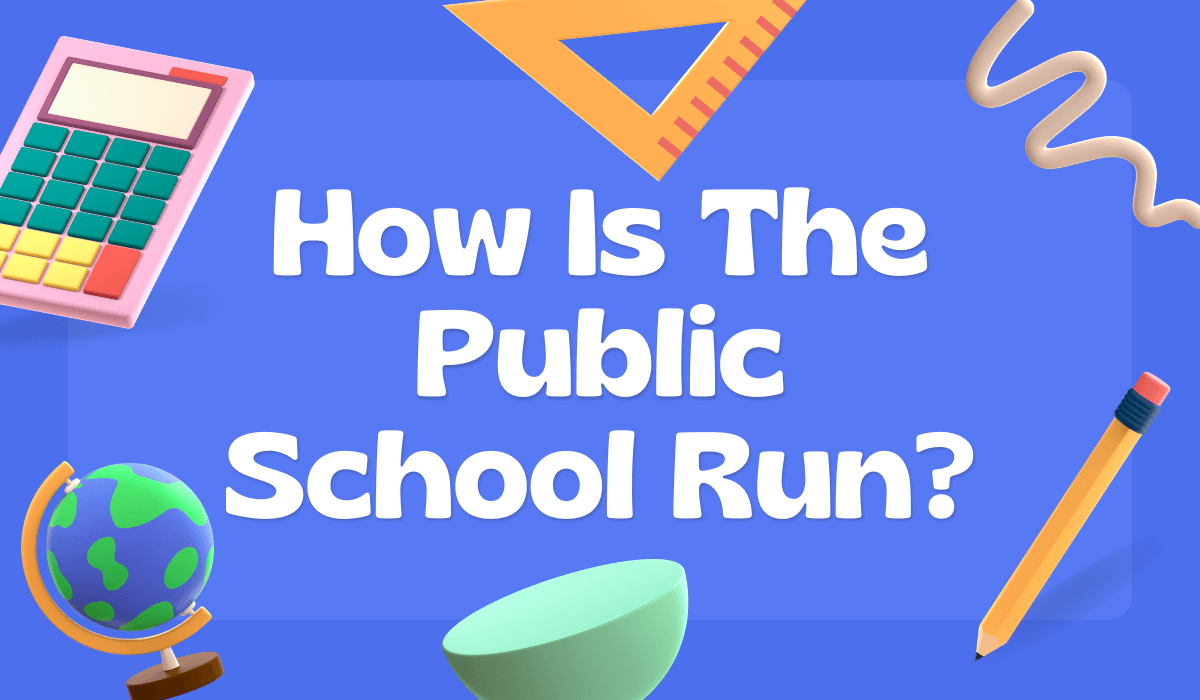
Age/Grade Conversion Chart USA
In the United States, students get admission in different grades based on their ages. Generally speaking, the grade a student is in corresponds to their age and the year they were born. Knowing this information helps parents make sure their children are in the right grade for their respective age when registering them for school or planning activities.
The age at which children enter kindergarten and first grade may vary depending on the school district and the state. It is best to check with your local school district for the age requirements for each grade.
What ages go with each grade in U.S?
Check out the list:
| Ages | US/International grades |
| 4-5 | Pre-kindergarten (Pre-school) /Early childhood |
| 5-6 | Kindergarten/ lower school |
| 6-7 | 1st grade |
| 7-8 | 2nd grade |
| 8-9 | 3rd grade |
| 9-10 | 4th grade |
| 10-11 | 5th grade |
| 11-12 | 6th grade/middle School |
| 12-13 | 7th grade |
| 13-14 | 8th grade |
| 14-15 | 9th grade (freshman) / High school |
| 15-16 | 10th grade (sophomore) |
| 16-17 | 11th grade (Junior) |
| 17-18 | 12th grade (Senior) |
A student’s age is an extremely important factor in determining which grade they should be enrolled in at school. But what ages are in what grades USA? It’s important to understand the age requirements for each grade so that parents can ensure their child is enrolled correctly and gets the most out of their education.
In US, a grade is more than just a symbol of academic achievement. It’s a measure of success and failure, motivation for hard work, or the source of anxiety for students everywhere. Grade in U.S can have an immense impact on our lives from college admissions to job interviews.
Grade in USA can be both liberating and restrictive. On one hand, it can open up doors to opportunities that would otherwise remain closed off; on the other hand, it can be used as an oppressive tool to stifle creativity and learning. Grades play an important role in determining who gets into certain colleges or universities, who receives scholarships, and even what kind of jobs we may get after graduation. This makes grades crucial to our future success – which means they shouldn’t be taken lightly!
What Is Preschool?

What Is Preschool?
Preschool is an educational program for children typically between the ages of three and five years old. Preschool gives young children the opportunity to learn foundational skills such as counting, letters, and shapes in a nurturing environment. In United States (U.S), preschool typically consists of half-day programs that are either publicly funded or privately run.
In the United States, most states provide public preschool options for children who are three to four years old. Generally these programs are free or at low cost for families who qualify for assistance through their local school district. Private preschools offer a variety of full-day programs with varying levels of tuition fees depending on their curriculum and amenities offered. Most parents choose private preschools due to their ability to tailor education specifically to the individual needs of their child; however, there are also a number of quality public preschool programs available in many communities across the country.
It is designed to teach basic socialization, communication and self-help skills to children. Although preschool may vary in structure and content depending on the region it is offered in, typically it serves as an introduction to more formal education processes.
In the United States, traditional elementary school begins with kindergarten at five years old and progresses through grade twelve. Each grade level follows an academic track and has specific age requirements – typically starting at five or six years old for kindergarten,
What Is K-12?

What Is K-12?
K-12 is an educational term used to refer to the primary and secondary education system in the United States. It encompasses kindergarten through 12th grade and covers children from ages 5 to 18. The K-12 system is one of the most widely used systems of grades among developed countries, although it does vary slightly from state to state.
In the US, public school students typically start kindergarten at age 5 and attend until they are around 18 years old. Elementary school spans grades 1 through 5 or 6, followed by middle school which consists of grades 6 or 7 through 8. High school then follows with 9th grade up through 12th grade. Upon successful completion of high school, students receive a diploma certifying their graduation from high school. Students may also choose to pursue higher education options such as college or trade schools after graduating from their K-12 program.
How Are Children Placed In Different Grades?
When it comes to how children are placed in different grades, the answer varies from country to country. In the United States, most states have a set age range for each grade level. Typically, children will enter kindergarten or first grade at about 5 years old and progress through 12th grade at age 18. However this is not always the case as some states allow younger students to skip grades if they are academically advanced or hold them back for various reasons.
In addition to age-based placement, there are also other criteria which may be used by schools when deciding what grade level is best for a student such as academic performance and social maturity levels. Parents can also request an evaluation of their child’s academic readiness before enrolling them in school so that they can make an informed decision regarding where their child should start their educational journey.
Children are placed in grades based on their age and educational readiness. Each grade typically covers a one-year period, with an established curriculum designed to challenge students as they progress through their education. It is important for parents to understand how their child is placed in different grades before beginning school.
The traditional grade level placement for children in the US starts at kindergarten or pre-kindergarten at age four or five. After that, children typically move up one grade level each year until they reach high school, usually by the time they are 16 years old. However, there may be some exceptions depending on local district policies and individual student needs. Some students may need additional assistance and may repeat a certain grade if necessary. Additionally, some districts offer accelerated classes that allow young students to skip grades or complete more advanced coursework earlier than usual.
Elementary Education In The United States
Elementary Education In The United States is an important topic of discussion. It is essential for parents and students to understand the stages involved in a student’s educational journey from kindergarten through primary school. One critical aspect of this process is determining what ages are in what grades USA.
The National Center for Education Statistics reports that children typically enter kindergarten at age five and then attend grades 1-6 until they reach 11-12 years old. Depending on their state, some school districts may also offer a PreK program, which would start at age four. Grade seven and above are typically considered middle or high school levels with the normal graduation age being 18 years old.
It is important to note that while there are general guidelines, each state has its own system of education and thus classifies elementary schools differently.
Secondary Education In The United States
Secondary education in the United States is an important part of ensuring that children receive a quality education. Many students begin their secondary school journey at the age of 11 or 12, when they enter middle school or junior high. From there, they continue on to high school and then complete their secondary education by graduating from a four-year college or university.
In the United States, grade levels are divided into elementary, middle and high school. Elementary schools typically cover grades kindergarten through five or six and are designed to help students learn basic skills like reading, writing and math. Middle schools generally include grades seven through eight or nine and help prepare students for the rigors of higher level learning in high school. High schools usually encompass grades nine through twelve, where core subject matter such as science, history and language arts are taught to educate young adults for life after graduation.
How Is The Public School Run?

How Is The Public School Run?
Public schools in the United States are run on a grade-level system, with students progressing through a series of grades from kindergarten to 12th grade. But how exactly is the public school system structured? In America, each state sets its own age requirements for children entering and advancing in public school.
In most states, the minimum age requirement for starting kindergarten is 5 years old. Typically, students must be 5 or 6 years old before they can enter first grade. After that point, they generally advance one grade per year until they reach high school. Then, depending on their state’s regulations and graduation requirements, they may proceed to grades 10-12 or 9-12. In some cases, students need to complete 8th grade before enrolling in high school; other states allow them to start at 9th grade if their academic record meets certain standards.
FAQ
If Your 11 What Grade Are You In?
Ans: Grade 6
What Grade Are You In At 12?
Ans: Grade 7
What Grade Is A 9 Year Old In?
Ans: Grade 4
What Grades Are 8 Year Olds In?
Ans: Grade 3
What Grade Is A 10 Year Old In?
Ans: Grade 5
What Grade Are 7 Year Olds In?
Ans: Grade 2
What Grade Should A 6 Year Old Be In?
Ans: Grade 1
Usa What Grade Are You In At 17?
Ans: 12th Grade (Senior)
When it comes to education, understanding what ages are in what grades in USA can be confusing. The age and grade of a student typically correspond to the number of years they have been enrolled in school. This means that each year students move up one grade level, adding one year to their age and educational experience. Generally speaking, students enter kindergarten at five years old, begin first grade at six years old, and continue through high school until they graduate at 18 years old.
The exact ages for grade can vary depending on the region or country you live in. In some countries, kindergarten is not mandatory and so the age range for first-grade starts as low as 4 or 5 years old and continues up until approximately 10 or 11 when elementary school ends.
You can usually find this information on the district websites, or you can contact your local school board office directly. We hope this information is helpful! Good luck!
Conclusion
In conclusion,the grade system of schooling in America is unique and varies greatly depending on the state. Generally, most states have elementary school for children between 5-11 years old, middle school for ages 11-14, and high school for 14-18 year olds. Grade levels may increase or decrease based on students’ ability level and academic progress. Moreover, some states offer alternative options to traditional schooling such as homeschooling or virtual learning.






